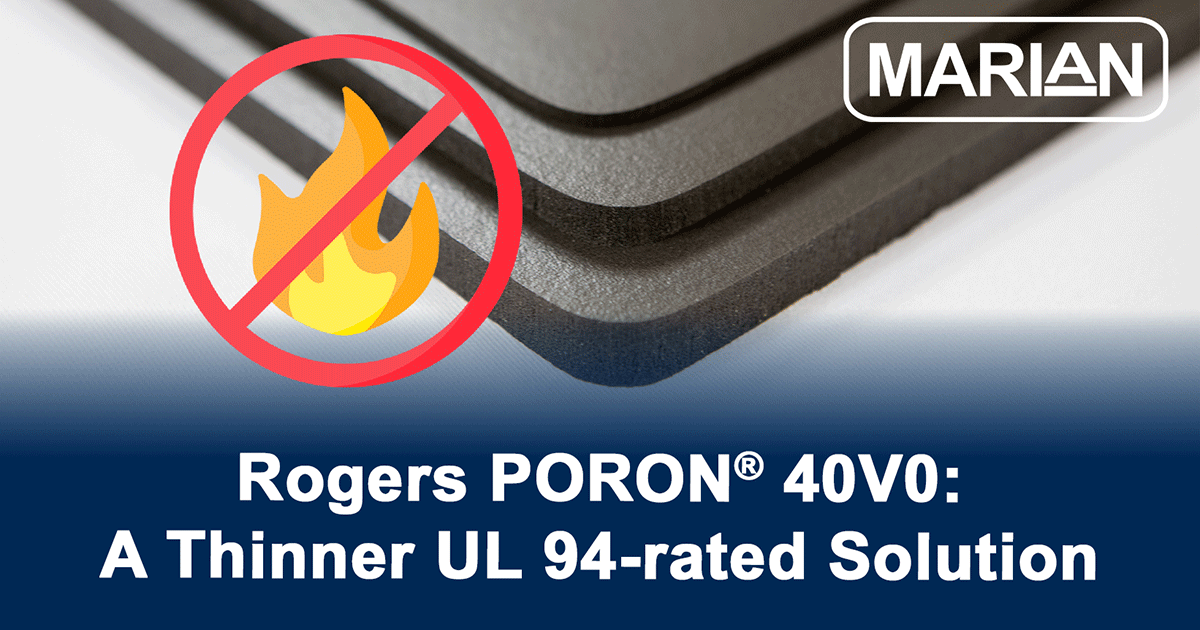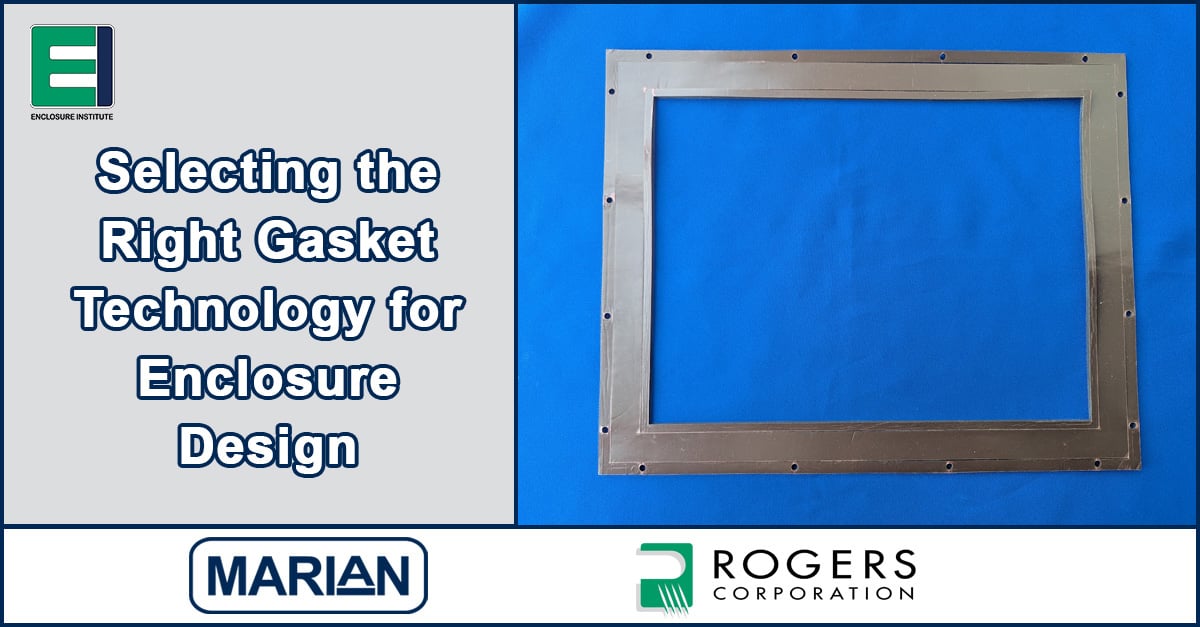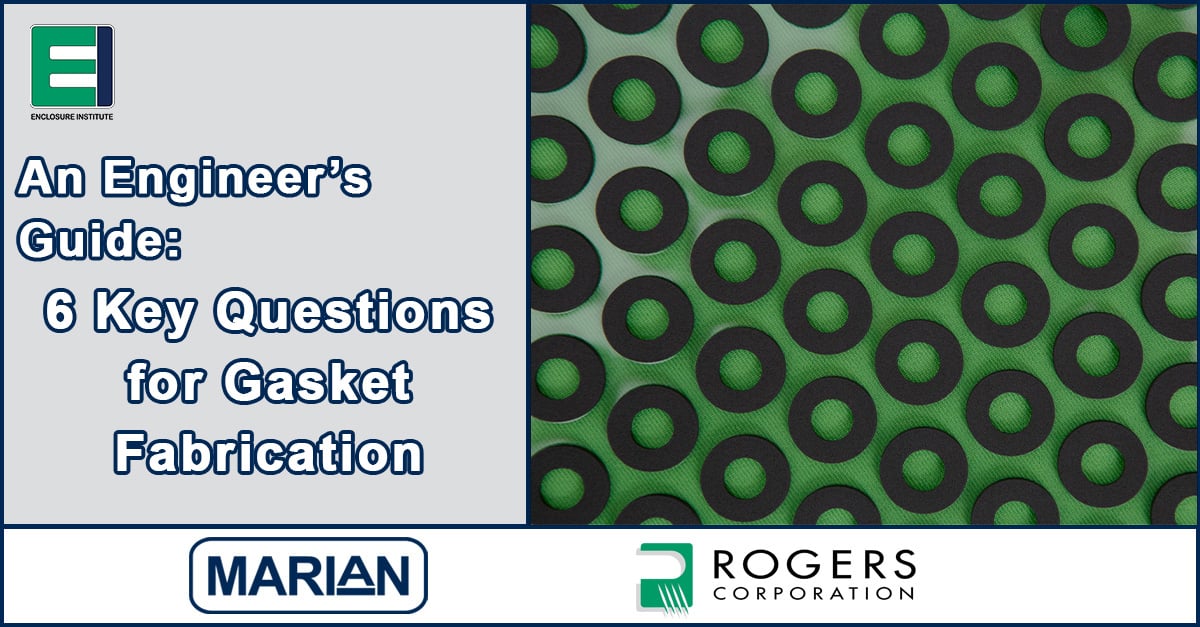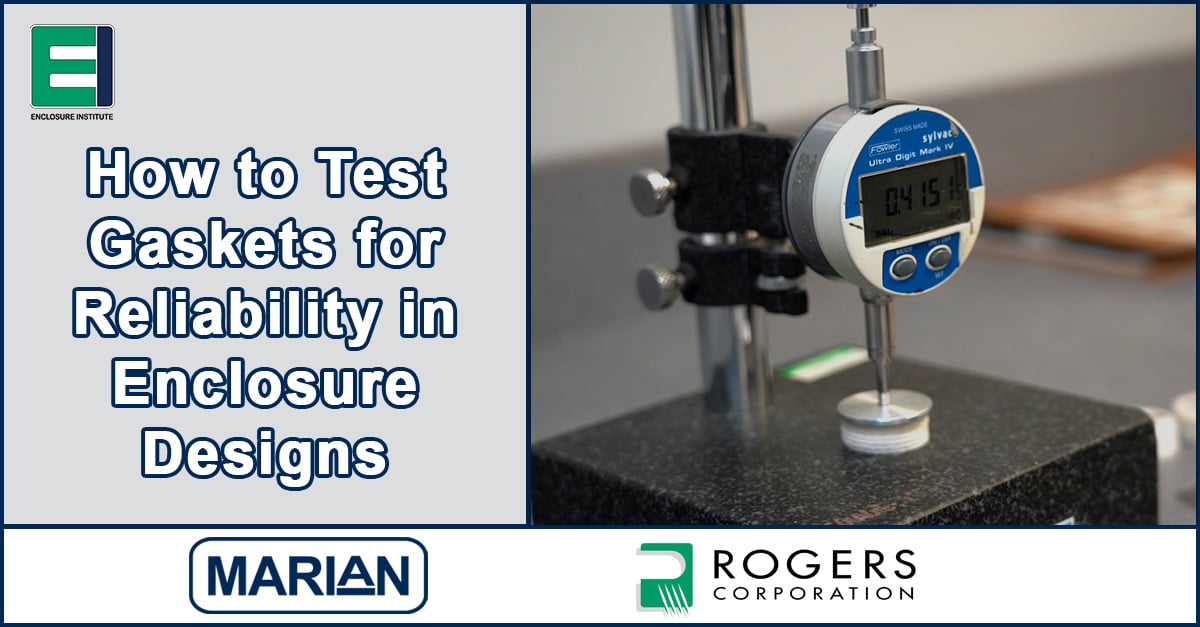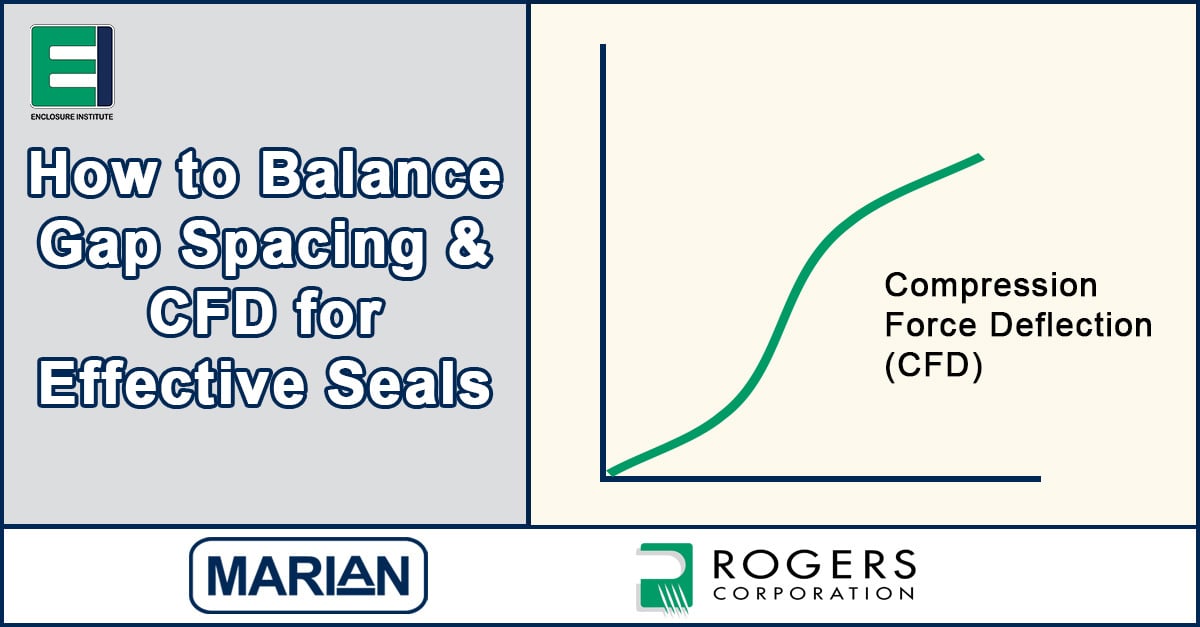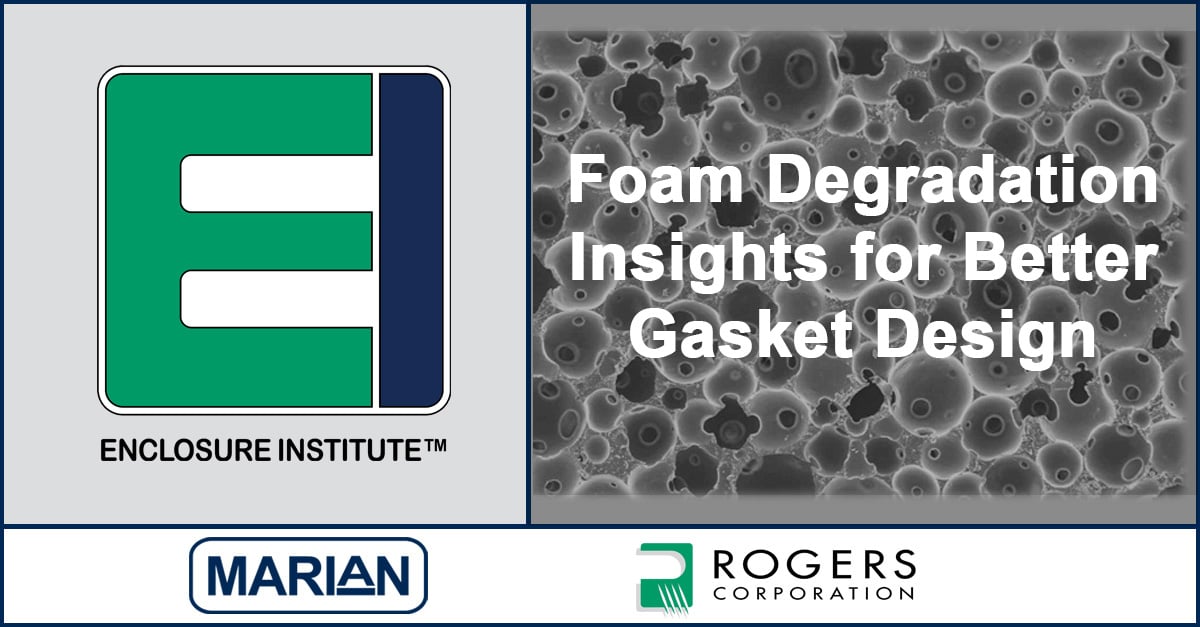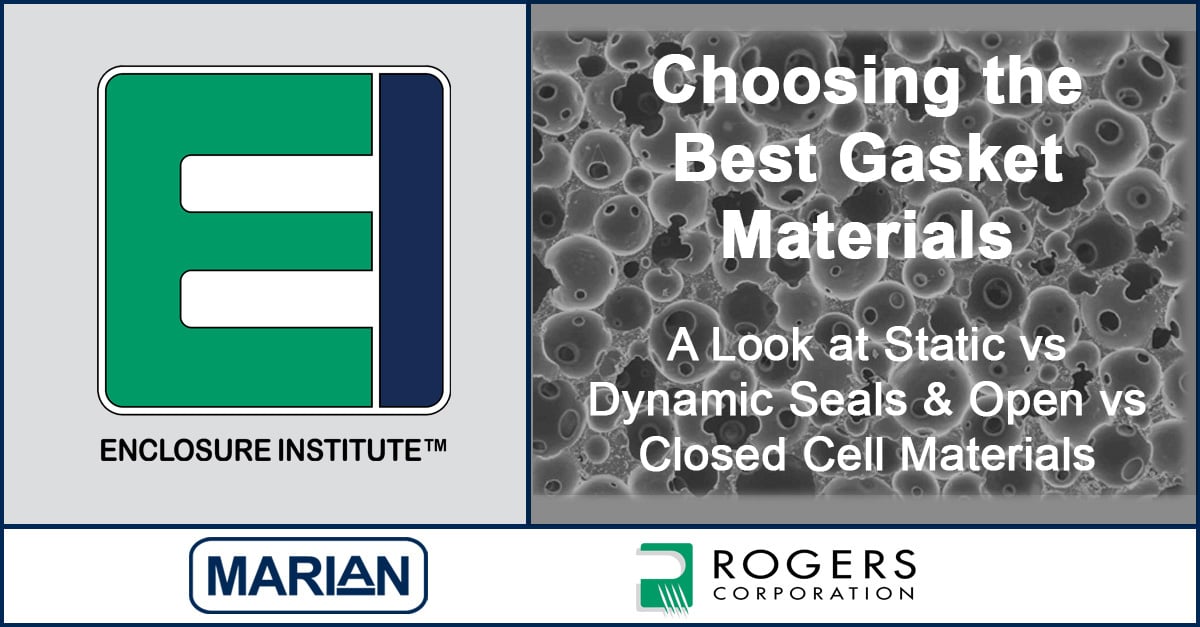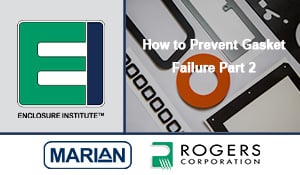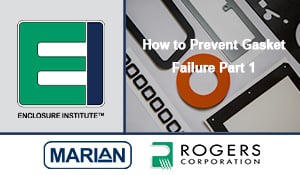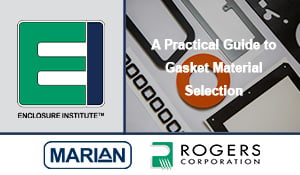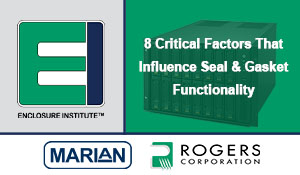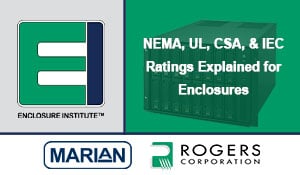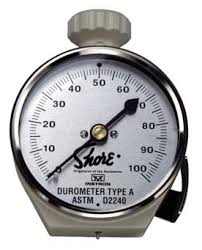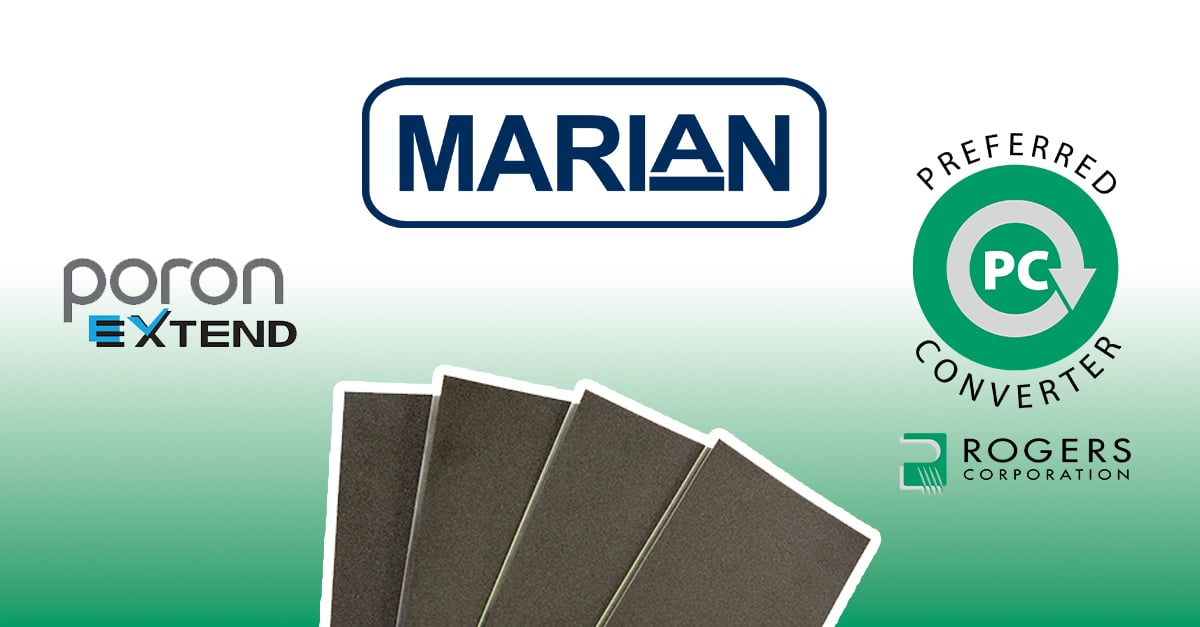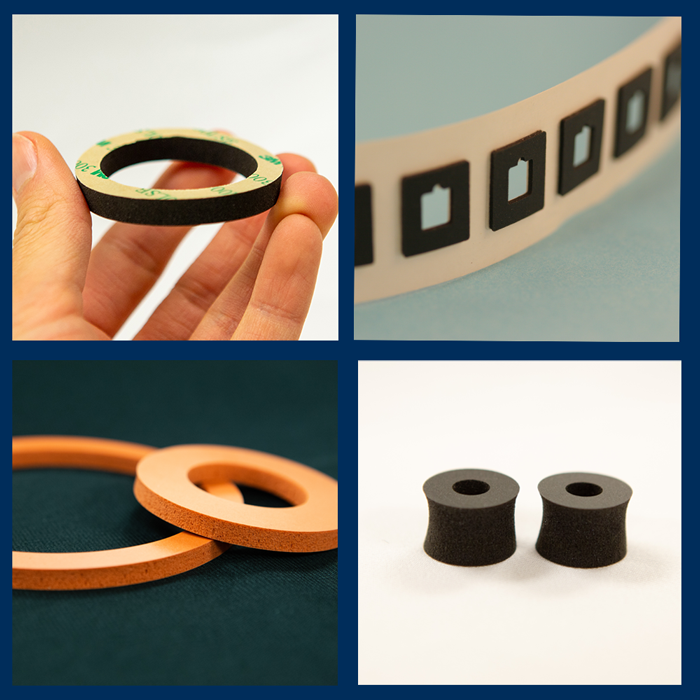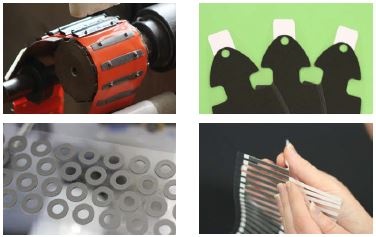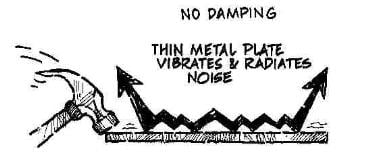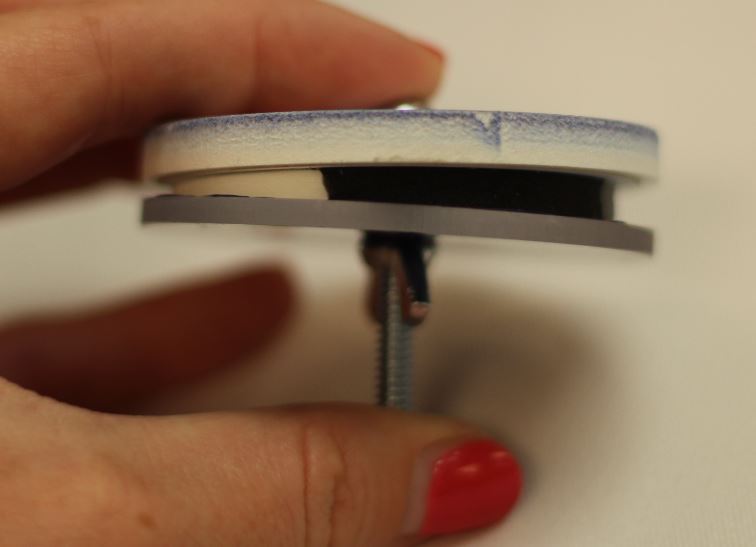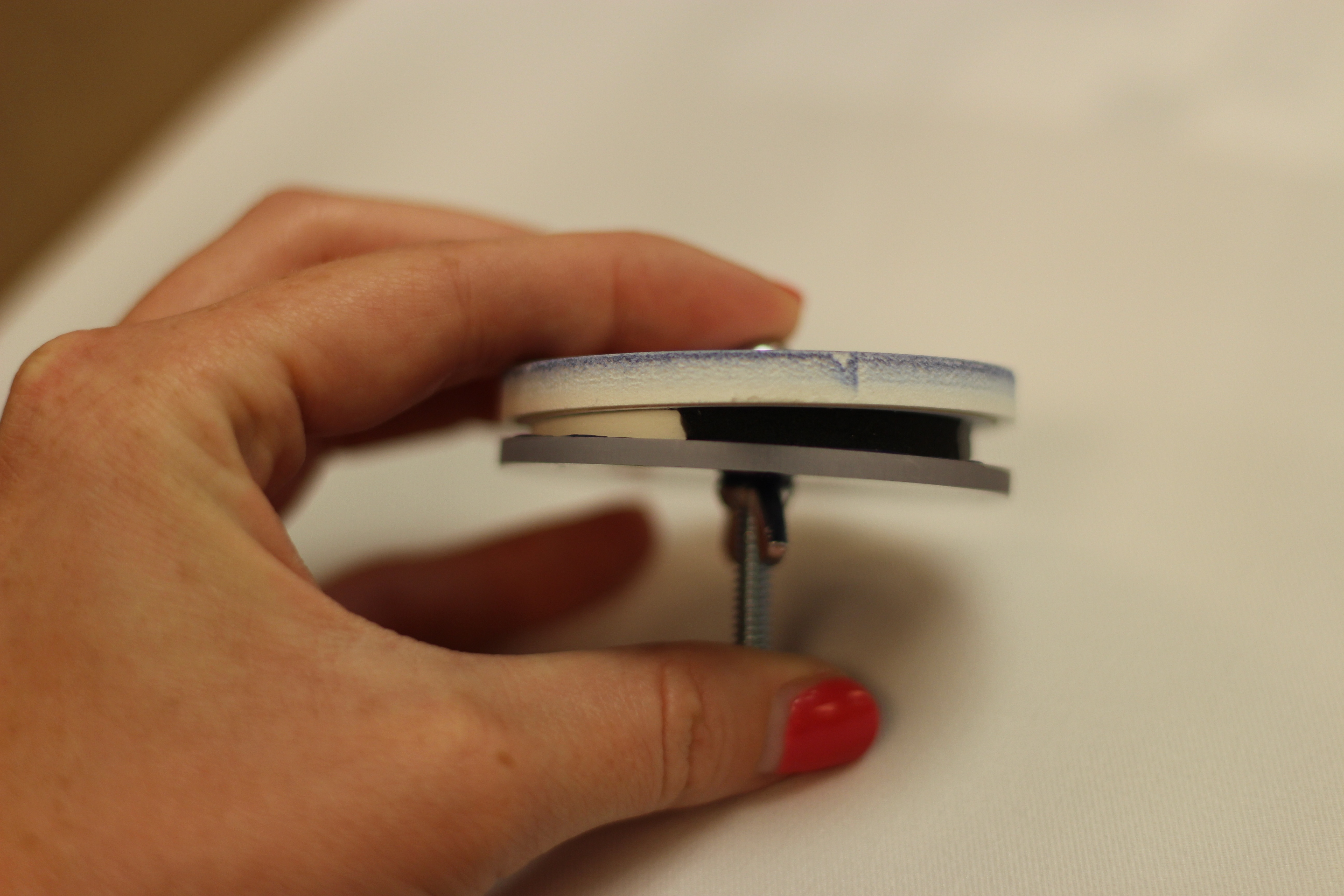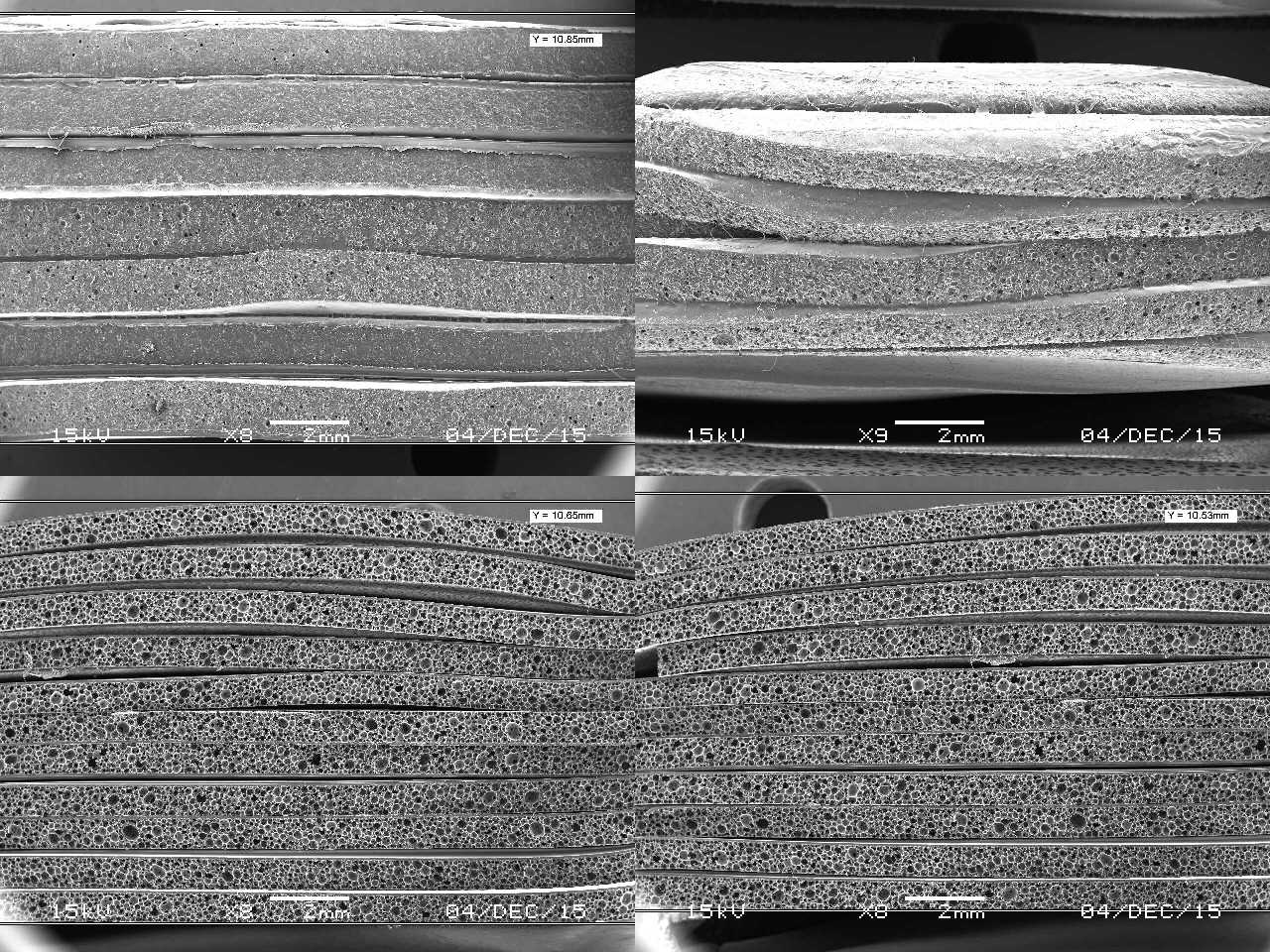Rogers Corporation’s PORON® 40V0 foam gives engineers a thinner, softer, and UL 94 compliant solution for gap filling and cushioning.
Unlike standard polyurethane foams, PORON 40V0 combines reliable flame resistance with enhanced compressibility in slimmer grades, making it ideal for space-constrained designs. It also meets strict environmental standards and minimizes contamination risks in critical applications.
Read More
Topics:
Thermal Management,
Foams,
Manufacturing,
PORON,
EV,
Battery,
Material selection,
Flame Barrier,
Automotive,
Sustainable Materials,
Rogers Corporation,
Data Center
As industries evolve toward smarter, smaller, and more connected technologies, enclosures are facing new challenges. Design engineers are under pressure to deliver lighter, thinner, and safer enclosures that protect sensitive electronics from harsh environments while still meeting demanding performance standards.
This shift is transforming how gaskets and seals are designed and what materials are being used across key markets such as electric vehicles (EVs), medical devices, energy storage systems (ESS), and data centers.
Check out the extended blog on the Rogers website, The Future of Sealing: How Tomorrow's Applications Are Changing, and the video below to see where enclosures are heading and what will be necessary by the teams designing these enclosures.
*Disclaimer: The Enclosure Institute™ is a free educational resource created by Marian, Inc. and Rogers Corporation to help engineers navigate enclosure sealing with expert guidance.
Read More
Topics:
Manufacturing,
PORON,
Vent Material,
Material selection,
Die Cutting,
Automated Assembly,
PTFE Membrane,
Gasket,
Assembly,
Enclosure Institute,
Seals,
Enclosures,
Rogers Corporation,
ePTFE
Effective venting is one of the most important yet overlooked aspects of enclosure design. Whether protecting sensitive electronics, automotive components, or sensor systems, proper venting ensures reliability, safety, and long-term performance. By understanding the role of a vent, how venting solution works, why they're necessary, and how to choose the right materials and designs, engineers can create enclosures that maintain functionality even in harsh environments.
Check out the extended blog on the Rogers website, How To Design Effective Enclosure Vents: Balancing Pressure, Moisture, and Protection, and the video below.
*Disclaimer: The Enclosure Institute™ is a free educational resource created by Marian, Inc. and Rogers Corporation to help engineers navigate enclosure sealing with expert guidance.
Read More
Topics:
Manufacturing,
PORON,
Vent Material,
Material selection,
Die Cutting,
Automated Assembly,
PTFE Membrane,
Gasket,
Assembly,
Enclosure Institute,
Seals,
Enclosures,
Rogers Corporation,
ePTFE
Gaskets and seals can be manufactured in a number of different ways, but which is the best form for your application? In our blog, "An Engineer's Guide: 6 Key Questions for Gasket Fabrication", we discussed a number of different processes that could be used to cut your custom gasket or seal like rotary die cutting, laser cutting, waterjet cutting, and more.
This Enclosure Institute™ content from Marian and Rogers Corporation focuses on the difference between die-cut foam gaskets and three other sealing methods: o-rings, cure-in-place (CIP), and foam-in-place (FIP) gaskets.
Check out a summary of our content below or read the full article on Rogers’ website.
Enroll in The Enclosure Institute™ to advance your sealing design expertise.
*Disclaimer: The Enclosure Institute™ is a free educational resource created by Marian, Inc. and Rogers Corporation to help engineers navigate enclosure sealing with expert guidance.
Read More
Topics:
Foams,
Manufacturing,
BISCO Silicone,
PORON,
Material selection,
Die Cutting,
Automated Assembly,
Gasket,
Assembly,
Enclosure Institute,
Seals,
Enclosures,
Rogers Corporation
Selecting the right fabrication process for custom seals and gaskets starts with answering a few critical design-for-manufacturing (DFM) questions. By addressing these factors upfront, design engineers can avoid costly redesigns, speed up production, and ensure that their parts meet application requirements. At Marian, our engineers use these questions (and more) to create a fabrication plan tailored to each project.
This guide is presented by the Enclosure Institute™. For a deeper dive, explore the extended blog on the Rogers website, Top 8 Best Practices You Need to Know for Enclosure Die-Cut Gaskets, along with the video below hosted by Marian's own Phil Taylor and Jimmy Budd.
In these resources, you'll learn how starting with the right gasket design can optimize geometry to balance sealing force, fasteners, and load distribution. You'll also see why selecting manufacturing methods that align with production scale is critical for efficiency. Assembly features such as pull-tabs, locating holes, and specialized adhesives help streamline installation and minimize errors. Finally, packaging and delivery strategies play an often-overlooked role in protecting gasket integrity while making assembly faster and more reliable.
*Disclaimer: The Enclosure Institute™ is a free educational resource created by Marian, Inc. and Rogers Corporation to help engineers navigate enclosure sealing with expert guidance.
Read More
Topics:
Foams,
Manufacturing,
BISCO Silicone,
PORON,
Material selection,
Die Cutting,
Automated Assembly,
Gasket,
Assembly,
Enclosure Institute,
Seals,
Enclosures,
Rogers Corporation
A seal’s true value isn’t in how it looks on day one, but in whether it still protects your enclosure years later under heat, moisture, and mechanical stress. This Enclosure Institute™ article breaks down five core tests engineers can use to validate long-term gasket reliability: compression set, stress relaxation, thermal cycling, chemical resistance, and IP ingress protection.
Check out the extended blog on the Rogers website, How To Validate Enclosure Seal Reliability Through 5 Tests, and the video below.
*Disclaimer: The Enclosure Institute™ is a free educational resource created by Marian, Inc. and Rogers Corporation to help engineers navigate enclosure sealing with expert guidance.
Read More
Topics:
Foams,
IP Rating,
BISCO Silicone,
CFD,
PORON,
Compression Set,
Material selection,
Die Cutting,
Ingress Protection,
Gasket,
Enclosure Institute,
Seals,
Enclosures,
Rogers Corporation,
Material Testing
Designing a dependable enclosure seal isn’t just about picking or designing a gasket, it’s about how that gasket behaves under compression, for the planned life of the device (hours, weeks, months, days, years, etc.), within your hardware’s mechanical limits. The latest article from the Enclosure Institute™ highlights four key factors that matter most: gap spacing, compression force deflection (CFD), material compressibility, and gasket width.
Check out the extended blog on the Rogers website, The Mechanics of Enclosure Seal Design: Gap Spacing, CFD, and Compressibility, and the video below.
*Disclaimer: The Enclosure Institute™ is a free educational resource created by Marian, Inc. and Rogers Corporation to help engineers navigate enclosure sealing with expert guidance.
Read More
Topics:
Foams,
BISCO Silicone,
CFD,
PORON,
Material selection,
Die Cutting,
Gasket,
PSA,
Enclosure Institute,
Seals,
Enclosures,
Rogers Corporation
Understanding how different foams degrade is critical to designing gaskets that deliver optimal performance for their intended lifespan in any application. Learn what “long-term” reliability means in real-world environments and how polymer degradation mechanisms impact sealing materials.
In this Enclosure Institute™ blog, Marian and Rogers Corporation explore the key factors contributing to foam material degradation, providing engineers with insights to design durable components that maintain reliable performance throughout the product’s operational life.
Check out the extended blog on the Rogers website, Expert Tips for Preventing Polymer Degradation in Enclosure Applications, and the video below.
*Disclaimer: The Enclosure Institute™ is a free educational resource created by Marian, Inc. and Rogers Corporation to help engineers navigate enclosure sealing with expert guidance.
Read More
Topics:
Foams,
BISCO Silicone,
PORON,
Material selection,
Die Cutting,
Gasket,
PSA,
Enclosure Institute,
Seals,
Enclosures,
Rogers Corporation
Material selection related to seal performance is highly application specific. When choosing a sealing material, it's important to first understand if your application will be used in a static or dynamic environment. This ensures the appropriate materials are being considered for a gasket that maximizes enclosure reliability while also preventing premature failure.
In this Enclosure Institute™ blog, Marian and Rogers Corporation break down the differences between a static and dynamic seal, the design implications, and the key material properties that matter most.
Check out the blog on the Rogers website, Everything You Need to Know About Static vs Dynamic Seals in Enclosures, and the video below. The video also dives a little deeper into open cell and closed cell materials, their performance characteristics, and the various testing methods to verify those characteristics.
*Disclaimer: The Enclosure Institute™ is a free educational resource created by Marian, Inc. and Rogers Corporation to help engineers navigate enclosure sealing with expert guidance.
Read More
Topics:
Foams,
BISCO Silicone,
PORON,
Material selection,
Die Cutting,
Gasket,
PSA,
Enclosure Institute,
Seals,
Enclosures,
Rogers Corporation
Not all sealing failures can be seen with the naked eye. Sometimes, subtle design oversights, improper installation, or even the application's environment if not planned for correctly can quietly undermine your enclosure’s performance.
There's a lot more than just material selection goes into designing a successful enclosure. In this case study, we highlight how Marian and Rogers Corporation teamed up to solve a moisture intrusion issue in a digital intercom system after the original gasket designed by a competitor allowed a leak to damage internal electrical components and, ultimately, caused the devices to fail.
The blog on the Rogers website, What Good Sealing with the Right Partner Looks Like, and the video below walk through how the Marian team recommended materials that effectively sealed the touchscreen modules and also prevented the leaks that previously caused failure.
Disclaimer: The Enclosure Institute™ is a free educational resource created by Marian, Inc. and Rogers Corporation to help engineers navigate enclosure sealing with expert guidance.
Read More
Topics:
Foams,
BISCO Silicone,
PORON,
Material selection,
Die Cutting,
Gasket,
PSA,
Enclosure Institute,
Seals,
Enclosures,
Rogers Corporation
While you might think pressure sensitive adhesives (PSAs) are pretty straightforward, selecting the wrong for your enclosure application can create problems and compromise sealing performance long before final assembly takes place.
Learn the key features of each adhesive type in latest blog on the Rogers website, How to Choose the Right PSA for Your Enclosure Components, and the video below to get an idea of which adhesives perform well in different situations. Once you have an understanding, you can start designing more reliable sealing components for your enclosure applications.
Disclaimer: The Enclosure Institute™ is a free educational resource created by Marian, Inc. and Rogers Corporation to help engineers navigate enclosure sealing with expert guidance.
Read More
Topics:
Foams,
BISCO Silicone,
PORON,
Material selection,
Die Cutting,
Gasket,
PSA,
Enclosure Institute,
Seals,
Enclosures,
Rogers Corporation
In Part 2 of our gasket failure series, we shift from the discussion on material science & environmental factors to mechanical design & real-world installation. Even a high-performance gasket can fail due to poor geometry, fastener placement, uneven compression, lack of venting, or improper gasket placement altogether.
Find the latest blog on the Rogers website, 6 Reasons Why Gaskets Fail: Design and Assembly, and the video below to start designing more reliable sealing components for your enclosure applications today.
Disclaimer: The Enclosure Institute™ is a free educational resource created by Marian, Inc. and Rogers Corporation to help engineers navigate enclosure sealing with expert guidance.
Read More
Topics:
Foams,
BISCO Silicone,
CFD,
PORON,
Compression Set,
Material selection,
Die Cutting,
Gasket,
Enclosure Institute,
Seals,
Enclosures,
Rogers Corporation,
Kiss-Cut,
Collapsible Gasket,
Multi-Piece Gasket,
Puzzle Gasket
Even the best-sealed enclosure can fail if the gasket material isn’t up to the challenge.
They say every failure is a step toward success, but we say that failure can be completely avoided by asking the right questions and having a clear understanding of your application's use case.
Lucky for you, we've condensed the important information we've learned over the years to help you make sure your enclosure is properly design right from the start. Check out the latest blog on the Rogers website, 6 Reasons Why Gaskets Fail: Materials and Environment, and the video below to start designing more reliable sealing components for your enclosure applications today.
Disclaimer: The Enclosure Institute™ is a free educational resource created by Marian, Inc. and Rogers Corporation to help engineers navigate enclosure sealing with expert guidance.
Read More
Topics:
Foams,
BISCO Silicone,
CFD,
PORON,
Compression Set,
Material selection,
Gasket,
Enclosure Institute,
Seals,
Enclosures,
Rogers Corporation
From silicone to neoprene, each gasket material comes with trade-offs and will perform best in various situations, but how do you know which is best for your application and where should you start?
Have no fear, engineers! The Enclosure Institute™ has created a comprehensive guide on the Rogers website in the newest blog: Top 8 Sealing Material Options: How to Choose the Right One for Your Enclosure.
This blog that breaks down the key differences in compression set resistance, temperature range, chemical compatibility, and cost across eight popular gasket options. With this guide and the Sealing Checklist Workbook (available exclusively to Enclosure Institute™ registrants), you're one step closer to sealing excellence.
Disclaimer: The Enclosure Institute™ is a free educational resource created by Marian, Inc. and Rogers Corporation to help engineers navigate enclosure sealing with expert guidance.
Read More
Topics:
Foams,
BISCO Silicone,
PORON,
Compression Set,
Silicone,
Material selection,
Gasket,
Enclosure Institute,
Seals,
Enclosures,
Rogers Corporation
“If it doesn’t seal, it’s not really an enclosure.” This engineer-focused resource from the Enclosure Institute™, a collaboration between Rogers Corporation and Marian, Inc., highlights eight practical factors for designing effective, long-lasting gaskets and seals. You can read the full article on the Rogers website.
Disclaimer: The Enclosure Institute™ is a free educational resource created by Marian, Inc. and Rogers Corporation to help engineers navigate enclosure sealing with expert guidance.
Read More
Topics:
Foams,
IP Rating,
BISCO Silicone,
CFD,
PORON,
Ingress Protection,
Gasket,
Electronics,
Enclosure Institute,
Seals,
Enclosures,
Rogers Corporation
NEMA (National Electrical Manufacturers Association), UL (Underwriters Laboratories), CSA (Canadian Standards Association), & IEC (International Electrotechnical Commission)—if you’ve ever felt overwhelmed by enclosure standards, our third blog from the Enclosure Institute™ is your go-to resource.
With so many standards guiding performance, safety, and environmental protection, it can be difficult to know which ones truly matter for your application. Whether you're designing for industrial environments, outdoor use, or specialized equipment, understanding these standards is critical—and easier than you think.
Disclaimer: The Enclosure Institute™ is a free educational resource created by Marian, Inc. and Rogers Corporation to help engineers navigate enclosure sealing with expert guidance.
Read More
Topics:
Foams,
IP Rating,
BISCO Silicone,
PORON,
Ingress Protection,
Gasket,
Electronics,
Enclosure Institute,
Seals,
Enclosures,
Rogers Corporation
What exactly are enclosures—and why does sealing matter so much? In this foundational blog from the Enclosure Institute™, we break down the role of enclosures across a range of industries, from EV charging to medical devices.
Read More
Topics:
Foams,
EMI Shielding,
IP Rating,
LED Lighting,
BISCO Silicone,
PORON,
Medical Device,
Ingress Protection,
Gasket,
Electronics,
Enclosure Institute,
Seals,
Enclosures,
Rogers Corporation,
Data Center
Sealing challenges can make or break the performance of an enclosure. That’s why Marian and Rogers Corporation have teamed up to launch the Enclosure Institute™ —a free educational series designed to help engineers tackle real-world sealing challenges with confidence.
Read More
Topics:
Foams,
BISCO Silicone,
PORON,
Enclosure Institute,
Seals,
Enclosures,
Rogers Corporation
The Shore durometer (pictured right) is a scale for measuring the hardness of a material, such as rubber, plastic, thermal
plastics (TPE), and rigid plastics. The term "durometer" is often used to describe a material's rating on the scale, for example “this material has a durometer of 60.”
It's worth noting, there are a variety of durometer scales since elastomeric and plastic resins vary over a wider range than one scale can accommodate. Download our comparison chart to see how these scales overlap.
Durometer hardness is one of many physical properties considered when selecting a material for a specific application.
Beware of some common misconceptions. Durometer hardness is often inaccurately confused with the properties described below.
Read More
Topics:
Foams,
CFD,
PORON,
Elastomers,
Material selection
Materials for Battery Solutions - PORON EVExtend®
One of our preferred material supplier, Rogers Corporation, has released PORON EVExtend® polyurethane foam material. This material is ideal for battery pads for EV/HEV li-ion pouch cell batteries. The EXExtend 4701-43HBF offers an increased flammability rating of HBF, or HF1 (product dependent).
Read More
Topics:
Foams,
PORON,
EV,
HEV,
Battery,
Material selection,
Thermal Gap Filler Pads,
Thermal Gap Pad
Technological advances in properties of soft, flexible foam and elastomeric materials have continued. These thick, soft, flexible foams and elastomers like PORON foam, silicone foam, and more are ideal materials for sealing, gasketing and cushioning across many industries and applications.
They compress, form to irregular surfaces, bend, and flex within an application without damage or delamination, but from the perspective of the converter, these materials may also introduce challenges when trying to achieve the tight dimensional tolerances common in metal and plastic-molded parts.
Read More
Topics:
Foams,
BISCO Silicone,
PORON,
Elastomers,
Tolerance
Why is it so important that plastic injection molding companies provide value added services and secondary manufacturing services to their customers after molding their parts?
The answer is easy! Many end-customers of plastic injection molders are looking for vendor consolidation and supply chain simplification. They want to cut out and skip steps in their supply chain, sequentially helping to reduce costs and save time.
Read More
Topics:
Foams,
Manufacturing,
Acrylic Foam Tape,
PORON,
PSA
In this newly released application story, a global designer and manufacturer of critical intercommunication devices experienced a gasket failure allowing moisture to leak and compromise the internal components of their console. It's remarkable the amount of damage a single drop of water can do. Moisture often contains impurities and minerals that remain even after the water evaporates. Between the moisture and these remaining elements, the contamination can cause short circuits, corrosion, and mechanical problems. A malfunctioning device leads to recalls, replacements, and eventually a poor reputation. The company in this story did NOT want to deal with any of this.
The intercom console product was intended to be used in medical office settings. Cleanliness and sanitary standards were very important for the high-touch surface of this device. The console was sprayed with liquid cleaners often. The console housing required a reliable sealing gasket to keep moisture out.
Read More
Topics:
Foams,
PORON
Just about everything that has been engineered is likely to experience vibration. Unfortunately, it has been proven that vibration can be responsible for causing extreme damage to some applications. The source of vibration can come from impact, internal motors or external sources.
Read More
Topics:
Foams,
PORON,
Damping
When choosing a foam for a product design, one feature that should be considered is the compression set resistance of the foam. C-Set is one of the most important characteristics to consider, and this blog post answers three basic questions to explain why.
Read More
Topics:
Foams,
BISCO Silicone,
PORON,
Compression Set,
Elastomers,
Material selection
Die-cut Components for Medical Devices
We believe that true stories can tell you more than any marketing materials that we create. That is why we are sharing two new case studies in this blog post. Both case studies explore die-cut solutions that Marian provided to medical device companies. Quality and reliability are critical in this industry. Additionally, assembly efficiency and cost savings are important to the success of the business. In these case studies, you will see that Marian is well equipped and prepared to meet the stringent requirements demanded by the medical device industry. Enjoy!
Read More
Topics:
Foams,
PORON,
Medical Device
Imagine going 65 mph in your vehicle while on a road trip. The road you are driving on is old, so your vehicle bobs up and down the many dips and divots, your speakers are loud and are causing your rearview mirror to vibrate, making it hard to see, and your moon roof has a roaring noise sneaking through the cracks.
These foul disturbances are examples of NVH, also known as Noise Vibration Harshness.
Read More
Topics:
Foams,
BISCO Silicone,
PORON
Marian has a brand-new demonstration piece to share with the world! Strategically named "Test My Memory," the demo illustrates the impact of compression cycling over time with 4 different foams. Neoprene, Polyethelyne, PORON Urethane, and BISCO Silicone are tested by being compressed for 48 hours.
Foam Material Compression
In the demonstration, you will see that certain foams depreciate as they take on impact over time, whereas other foams resist the compression set by returning to their original thickness. The material characteristic of being able to take a compression set, also called compression force defection, is extremely important in long-term sealing applications. The ability of the material to "push back" to fill in any potential gaps that would allow water or dust to pass through is critical. This makes such materials an excellent option for sealing gaskets. We wrote an entire blog post about compression force deflection, you can read it here: Compression Force Deflection in Foam Gaskets: A Critical Property
Read More
Topics:
Foams,
BISCO Silicone,
CFD,
PORON
Compression Force Deflection
Applications that experience periodic compression cycling over time may require a gasket that is capable of compression rebound. In the event that your application uses a material that does not resist compression force, the material may depreciate over time. When your gasket has dwindled or has deteriorated from all of the periodic compression cycling, your gasket will become ineffective and will need to be replaced. In a perfect world, your gasket should rebound to fill any potential gaps. Using a material with great compression resistance will guarantee a long-term sealing performance that will work just as effectively each time you reseal your application.
Read More
Topics:
Foams,
BISCO Silicone,
CFD,
PORON

